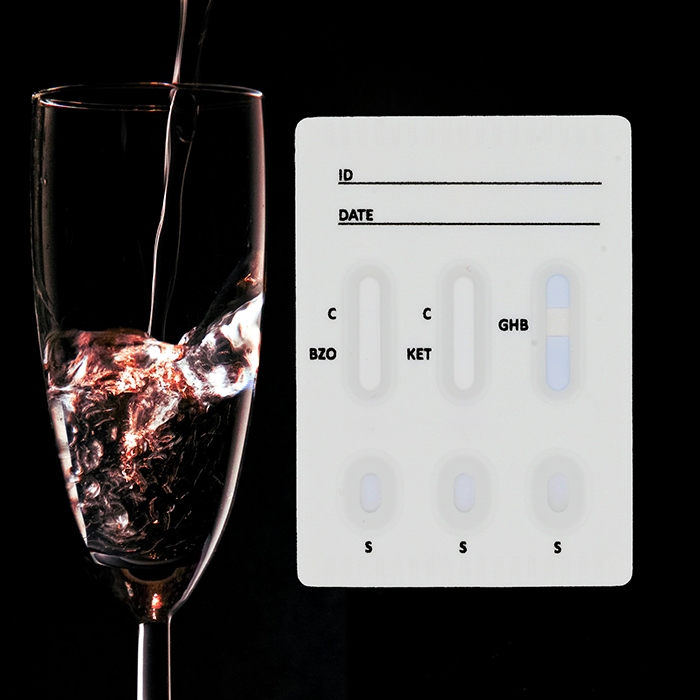
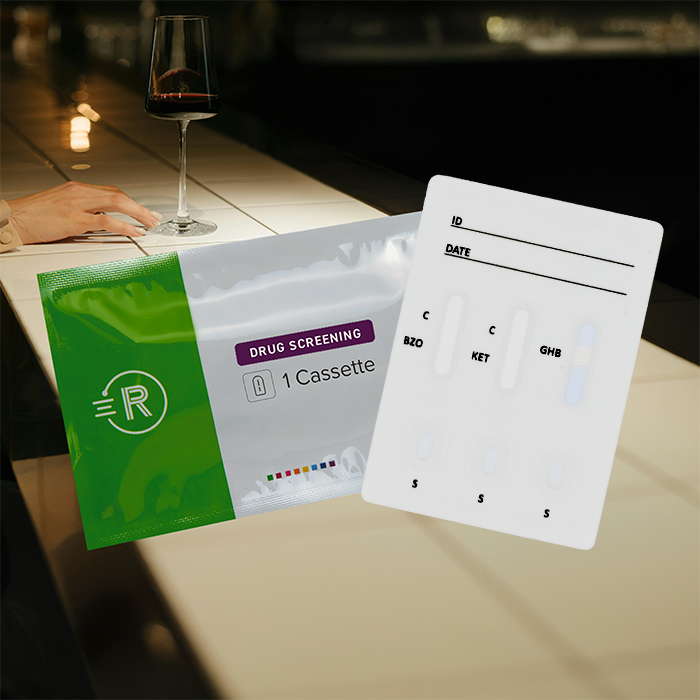
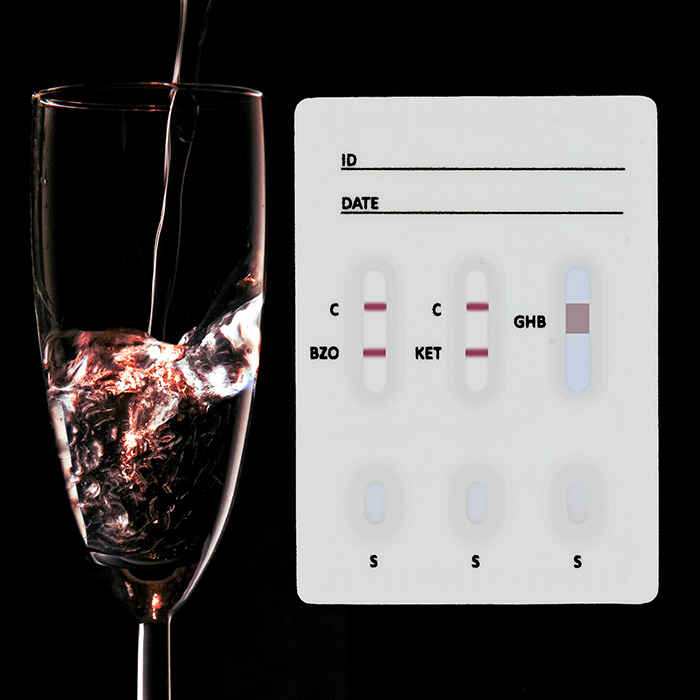
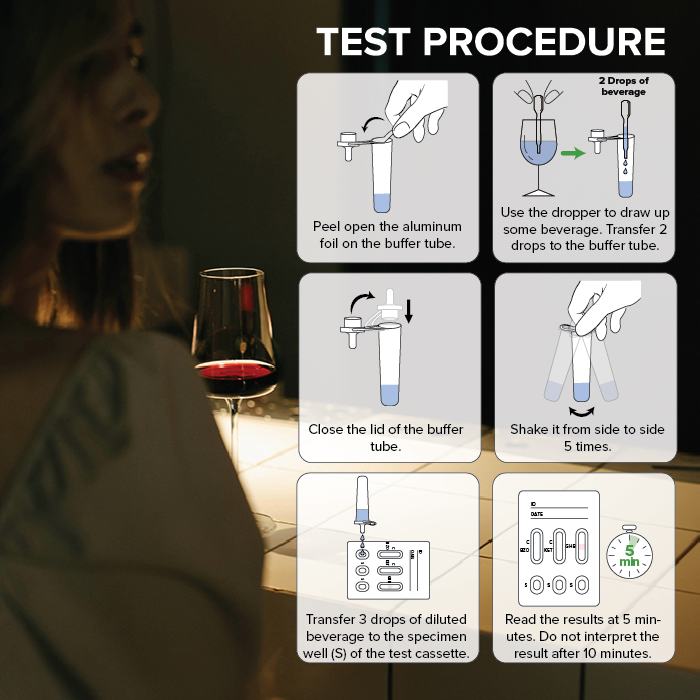
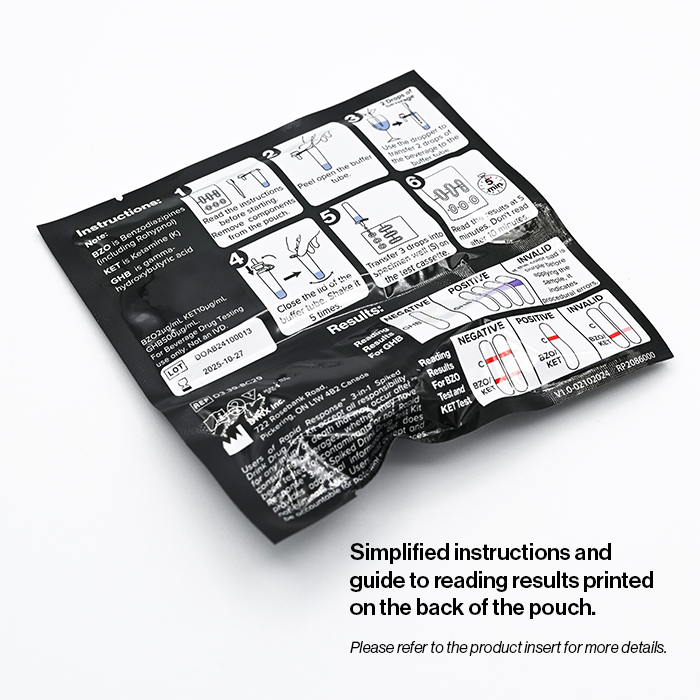
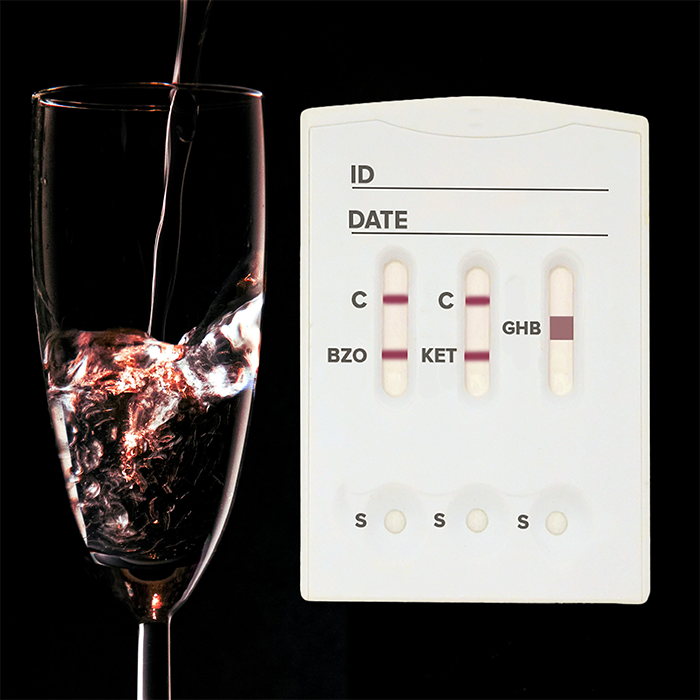
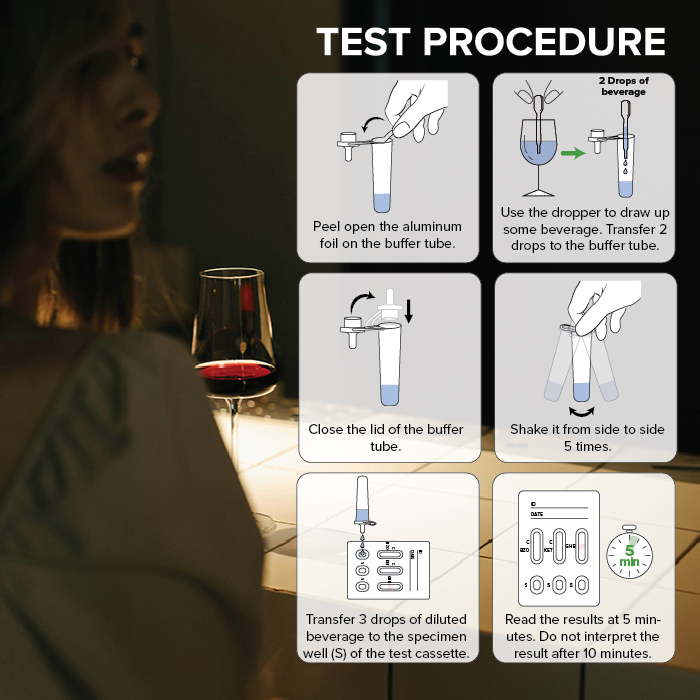
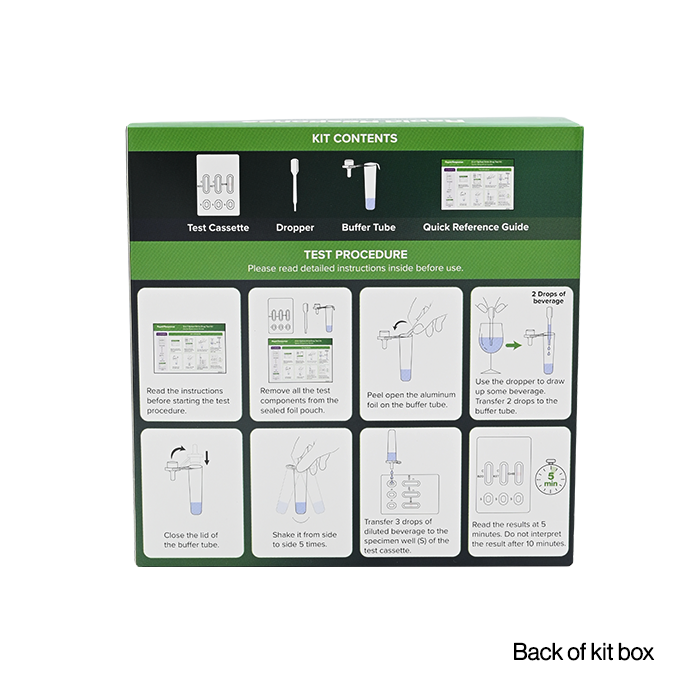
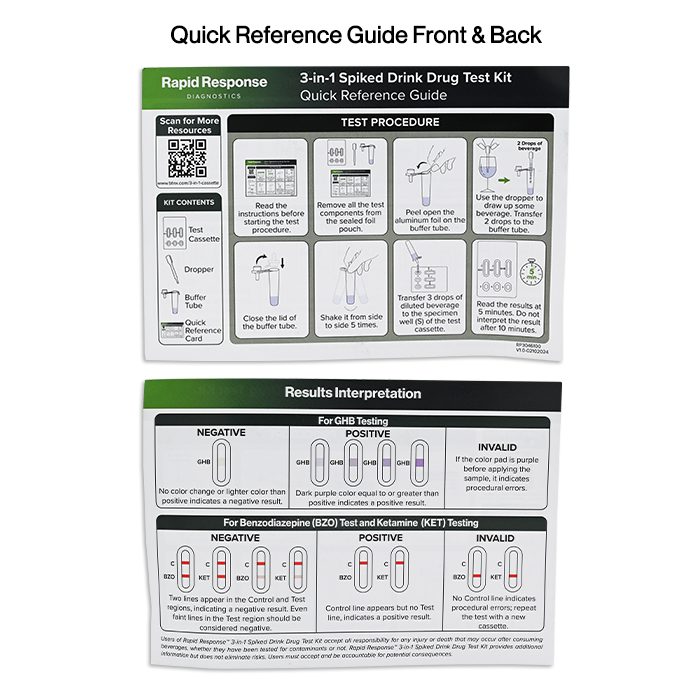











In social settings where beverage tampering or spiking is a concern testing your beverage is a defensive step to protect against potential harm. The Rapid Response™ 3-in-1 Spiked Drink Drug Test Kit is an advanced multi-drug test capable of detecting three common drug used for drug-facilitated sexual assault (date-rape drugs) in beverages: Benzodiazepines (BZO2), Ketamine (KET10) and GHB (GHB500).
| Test | Calibrator | Cut-off |
| Benzodiazepines (BZO) | Flunitrazepam |
Detects Benzodiazepines at cut-off levels above 2µg/mL. |
| Ketamine (KET) | Ketamine |
Detects Ketamine at cut-off levels above 10µg/mL. |
| γ-Hydroxybutyric acid (GHB) | γ-Hydroxybutyric acid |
Detects GHB at cut-off levels above 500µg/mL. |
- Test cassettes
- Quick reference guide (when applicable)
- Product insert
- Sample dilution buffer tubes
- Droppers
In social settings where beverage tampering or spiking is a concern testing your beverage is a defensive step to protect against potential harm. The Rapid Response™ 3-in-1 Spiked Drink Drug Test Kit is an advanced multi-drug test capable of detecting three common drug used for drug-facilitated sexual assault (date-rape drugs) in beverages: Benzodiazepines (BZO2), Ketamine (KET10) and GHB (GHB500).
| Test | Calibrator | Cut-off |
| Benzodiazepines (BZO) | Flunitrazepam |
Detects Benzodiazepines at cut-off levels above 2µg/mL. |
| Ketamine (KET) | Ketamine |
Detects Ketamine at cut-off levels above 10µg/mL. |
| γ-Hydroxybutyric acid (GHB) | γ-Hydroxybutyric acid |
Detects GHB at cut-off levels above 500µg/mL. |
Quick and Easy Testing
Results within Minutes
3-in-1: Test for three common controlled substances in beverages.
Portable and Convenient
Peace of Mind
AB-1524 Postsecondary education: on-campus access to drug testing devices.
AB 1524 requires the California State University and community college districts to stock drug testing devices, available and accessible, free-of-charge, in the health center located on each campus and post a notice on these requirements in a prominent and conspicuous location, as specified. The bill encourages the University of California, independent institutions of higher education, and private post-secondary educational institutions to implement these provisions. The bill imposes a state-mandated local program.
(1) “Controlled substances” includes, but is not limited to, flunitrazepam, ketamine, and gamma hydroxybutyric acid, which is also known by other names, including, but not limited to, GHB, gamma hydroxyl butyrate, 4-hydroxybutyrate, 4-hydroxybutanoic acid, sodium oxybate, and sodium oxybutyrate.
(2) “Drug testing devices” means test strips, stickers, straws, and other devices designed to detect the presence of controlled substances in a drink.
AB-1013 On-sale general public premises: drug testing devices.
Type 48 license holders are required to offer for sale to their customers drug testing devices, for detecting controlled substances in a drink (used to "spike" drinks, referred as "date rape" drugs or "roofies"), at a cost not to exceed a reasonable amount based on the wholesale cost of those devices. The bill will require a licensee to post a related notice containing specified language in a prominent and conspicuous location.
(b) An applicant for a new permanent on-sale general public premises (Type 48) license or the holder of an existing Type 48 license shall offer for sale to their customers drug testing devices at a cost not to exceed a reasonable amount based on the wholesale cost of those devices.
(c) A licensee subject to subdivision (b) shall post the following notice in a prominent and conspicuous location:
“Don’t get roofied! Drink spiking drug test kits available here. Ask a staff member for details.”
Benzodiazepines are medications that are frequently prescribed for the symptomatic treatment of anxiety and sleep disorders. They produce their effects via specific receptors involving a neurochemical called γ aminobutyric acid (GABA). Because they are safer and more effective, benzodiazepines have replaced barbiturates in the treatment of both anxiety and insomnia. Benzodiazepines are also used as sedatives before some surgical and medical procedures, and for the treatment of seizure disorders and alcohol withdrawal.
At higher doses, benzodiazepines can produce dissociation effects and anterograde amnesia during the effects. Benzodiazepines also have little to no taste or odor. Because of this, benzodiazepines can be unknowingly slipped into drinks and ingested. Due to the combination of properties, benzodiazepines are commonly associated with drug-facilitated sexual assault, known as a “date rape” drug.
Ketamine is a dissociative anesthetic developed in 1963 to replace PCP (Phencyclidine). While Ketamine is still used in human anesthesia and veterinary medicine, it is becoming increasingly abused as a street drug. Ketamine is molecularly similar to PCP and thus creates similar effects including numbness, loss of coordination, sense of invulnerability, muscle rigidity, aggressive / violent behavior, slurred or blocked speech, exaggerated sense of strength, and a blank stare. There is depression of respiratory function but not of the central nervous system, and cardiovascular function is maintained. The effects of Ketamine generally last 4-6 hours following use [1]. Ketamine is colorless and odorless. Due to this property, Ketamine can be unknowingly slipped into drinks and ingested. In combination with the dissociative effects, Ketamine is usually associated with drug-facilitated sexual assault.
γ-Hydroxybutyric acid (GHB) is an endogenous metabolite in the brain and peripheral organs. It has many characteristics of a neurotransmitter and has been studied for potential therapeutic use in the treatment of narcolepsy, drug addiction, and symptoms of withdrawal and to induce anesthesia. However, GHB also is widely abused. At higher doses, GHB produces sedation and a trance-like state with loss of memory. Because it has little smell or taste, it can be ingested un-knowingly.
This combination of properties has made GHB a drug used for drug-facilitated sexual assault, often administered to victims in beverages [2,3].
| Test | Calibrator | Cut-off |
| Benzodiazepines (BZO) | Flunitrazepam |
Detects Benzodiazepines at cut-off levels above 2µg/mL. |
| Ketamine (KET) | Ketamine |
Detects Ketamine at cut-off levels above 10µg/mL. |
| γ-Hydroxybutyric acid (GHB) | γ-Hydroxybutyric acid |
Detects GHB at cut-off levels above 500µg/mL. |
- Baselt RC. Disposition of Toxic Drugs and Chemicals in Man. 6th Ed. Biomedical Publ., Foster City, CA 2002.
- Bravo D T, Harris D O, Parsons S M. Reliable, Sensitive, Rapid and Quantitative Enzyme-Based Assay for Gamma-Hydroxybutyric Acid(GHB)[J].Journal of Forensic Sciences, 2004, 49(2):379-387.
- Ureda N, Ruan W, French D, et al. Lack of gamma-hydroxybutyrate prevalence among an urban emergency department population[J]. Journal of Analytical Toxicology, 2010, 34(2):110-111.
- Parsons S M, Harris D O, Bravo D T. Methods, compositions and apparatuses for detection of gamma-hydroxybutyric acid (GHB):US10098811[P]. US06703216 B2 [2023-11-03].
- For beverage drug testing use only. Not an IVD.
- This test is NOT intended to determine the purity, composition, or if the liquid being examined is safe to use. A positive or negative test result is NOT a guarantee that the liquid being tested is safe or unsafe to use. Any tested liquid is consumed or used at the consumer’s own risk.
- Rapid Response™ 3-in-1 Spiked Drink Drug Test Kit provides information to consumers but does not eliminate risks. Users of Rapid Response™ 3-in-1 Spiked Drink Drug Test Kit accept responsibility for any consequences, including injury or death, that may occur after consuming a tested liquid.
- Many factors come into play when testing a liquid, including but not limited to mixture of multiple substances, solubility, and pH of the sample.
- Technical or procedural errors, as well as other substances, and factors may affect the accuracy of the Rapid Response™ 3-in-1 Spiked Drink Drug Test Kit and can cause false results.
- A positive result indicates the presence of GHB, Ketamine, and/or Benzodiazepine only and does not indicate quantity or concentration.
- A negative result does not rule out the presence of GHB, Ketamine, and/or Benzodiazepine, or any other potentially harmful substances.
